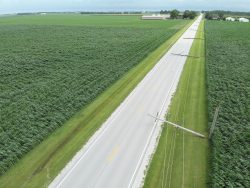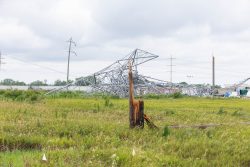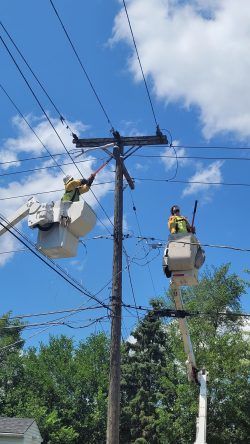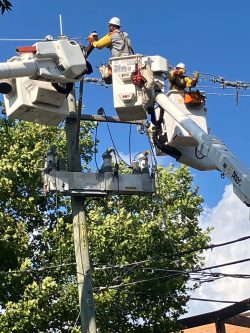Groundwork Pays Off: More than 400,000 Outages Avoided Amid Historic Summer Storm Season
November 1, 2024
The summer season typically brings increased storm activity across the northern Illinois region prompting our crews to undergo year-round preparations to keep customers connected to power during the peak seasons for electricity demand. And while the storms of summer 2024 brought intensity and damage unlike any summers before it – ComEd upheld our reliability for customers, with fast restoration times and technology upgrades that successfully helped stave off more than 400,000 outages during severe storms and tornadoes impacting the system.

This year’s summer activity – including a notable storm event in July that produced over 40 tornadoes and unprecedented damage over three days (July 13-15) – put the team and all of their preparedness to the test.
“This storm season tested our grid and our processes, but our employees rose to the occasion to get customers restored in record time and minimize the impact to their lives,” said Dave Perez, executive vice-president and chief operating officer for ComEd. “While we know that outages in any amount can pose dire inconveniences to our customers and communities, and we work quickly to address them, what we know from the mid-July storm is that investments in modernizing the grid and Smart Grid technology are paying off. Our advanced technology successfully prevented more than 400,000 additional customer outages from occurring on the system just during the mid-July storm event alone.”
The summer of 2024 was record-setting in many ways. On June 13, a severe storm moved through the south region of ComEd’s territory. As a result of this storm, 33 lattice structures supporting transmission lines were taken down. By comparison, the second largest number of structures that needed to be replaced in one year was in 2010 when 21 needed to be replaced over the course of the year.


Another system of severe weather moved through ComEd’s service territory from July 13-15. This series of storms produced 42 tornadoes, including 32 in one day, 10 occurring simultaneously and four touching down in the heart of the city of Chicago, a rare occurrence. The storm also took down an additional 27 lattice structures and damaged 11 more, with downed lines even leading to blocked lanes on Interstate-55 in the Channahon area. All in all more than 550,000 customers were impacted from the 3-day July storm system, but this event led to one of ComEd’s fastest restorations.
“The ComEd transmission system is the arterial flow of energy from power plants to the ComEd distribution system,” said Perez. “These storms caused unprecedented damage to our transmission structures. However, working in close collaboration with state police, our crews were able to safely remove and restore the lines within 48 hours.”
Crews began work immediately to restore impacted customers – with more than 67 percent, or 370,000 restored, within the first 12 hours, and more than 99.9 percent by the end of the week. Seven basecamps were established around the ComEd service territory for the quick dispatch of crews and materials. More than 2,000 contractors from 21 states, as well as teams from Puerto Rico and Canada, were brought in to aid in a swift and safe restoration.
While ComEd is proud of its crews for the restoration times in response to the devastating 3-day July storm – it’s also grateful for infrastructure investments that helped ensure the impact wasn’t more severe. The company estimates that more than 400,000 outages were avoided due to Smart Grid technology on the system.
Investments in technology for more than a decade have hardened our power grid system against increasing instances of severe weather. In comparison to our last major storm, in August of 2020, when a derecho moved through northern Illinois and produced 13 tornadoes, more than 800,000 customers lost power. Without the investments ComEd has made in the grid, it is estimated that the number of customers that would have been impacted by the July 2024 storms alone is close to one million.

The surge in storms may lead many to wonder – what’s driving this activity? Climate change is shaping weather patterns across the world and here in northern Illinois. Last year, Illinois led the nation in tornadoes with 121 reported by the National Weather Service. Illinois averages 50 tornadoes per year. So far, in 2024, we’ve had more than 100 tornadoes.
ComEd has embarked on a climate risk and adaption outlook study to evaluate future climate risks to our infrastructure and operations. We have partnered with Argonne National Labs to study what the next 25 years looks like in northern Illinois. Analysis shows that projected mid-century climate conditions for ComEd’s northern Illinois service territory are likely to be substantially warmer during all seasons and more humid than historical conditions. In particular, the area will experience more intense and prolonged heatwaves in summer months, which will be amplified by higher humidity.
“Each storm gives us the opportunity to review our response, determine how we can do better the next time and better understand how we invest in the system to minimize the impact of weather,” said Perez. “We know the next storm system could be right around the corner and we will be ready to meet the challenges.”
